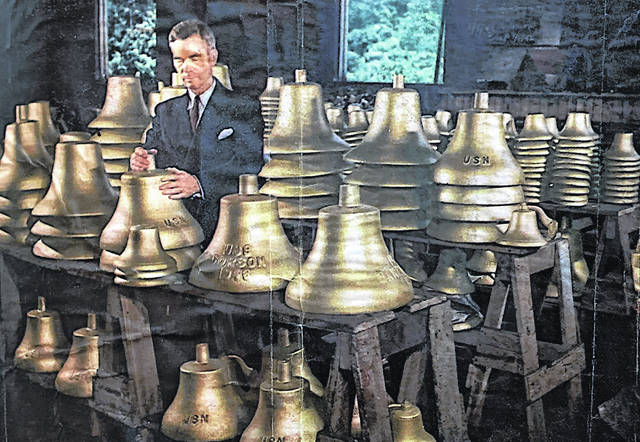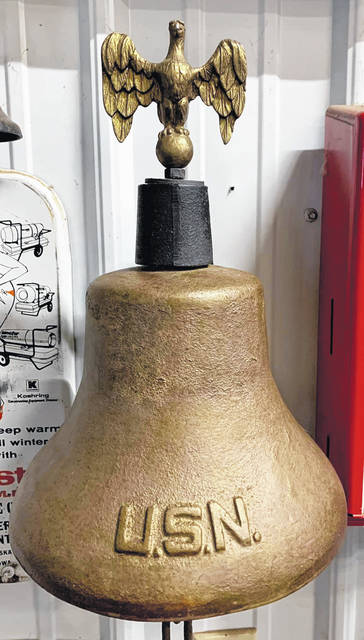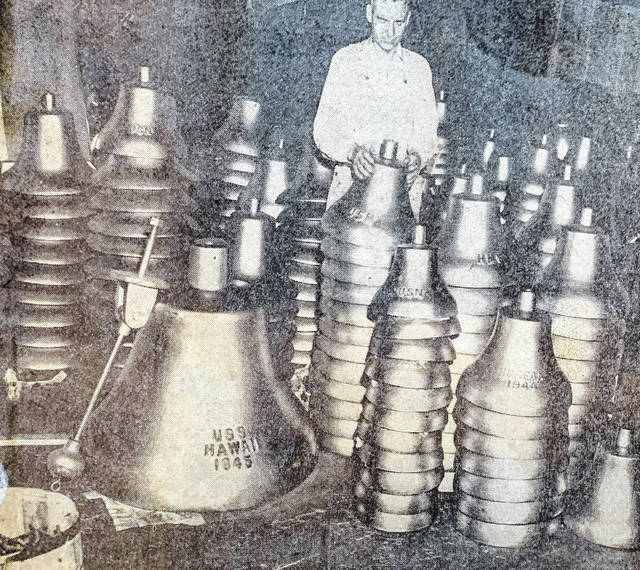


D-day and Memorial Day are significant in United States history, and are directly linked to the C. S. Bell Company in Hillsboro.
Noted Hillsboro historian Jean Wallis pointed out in her 1970s research the implications of the C. S. Bell Company supplying tens of thousands of bells to the Allied Forces during World War II.
“The most famous bell that the company made is a nine and three-quarter inch bell weighing 20 pounds and known as the invasion bell.” Wallis wrote. “These bells were used before dawn broke through the pitch black of the morning of June 6, 1944. The Allied invasion of 4,000 landing craft moving across the choppy channel amidst the fog and rain used thousands of invasion bells made in Hillsboro.”
She pointed out that, “These bells rang out the signals between the landing craft as they made their way to the coast and the sandy beaches of Normandy beginning the greatest military operation of all time.”
The whole invasion fleet, drawn from eight different navies, was comprised of 6,939 vessels: 1,213 warships, 4,126 landing craft of various types, 736 ancillary craft, and 864 merchant vessels. The vast majority of war ships and landing craft were outfitted with cast iron bells made in Hillsboro by C. S. Bell Company workers.
And that leads us to the rest of the story. Supplying all the bells for the three major Allied Forces? That’s a tall order. How did it happen?
The answer is Virginia Bell, granddaughter of Charles Singleton (C. S.) Bell, and daughter of C. E. Bell. Her grandfather was very successful and a manufacturing pioneer. Each of his plants were cutting edge, casting top quality grinders, mills and bells.
Virginia’s dad, C. E. Bell, was a marketing whiz who created distribution channels with major catalog companies and established supply chains in the United States and South America.
Virginia’s brother, Chick Bell, the third generation, was chosen to run the company as was the practice in those days, but wasn’t cut from the same cloth as his dad and grandfather.
Virginia went off to New York City to advance her career as an actress, but never cut her ties to the foundry back home. She was close to her dad and grandfather and no doubt kept them posted on the metals markets traded in New York City.
Fast forward to the 1930s. Virginia grandfather and father had passed away and her brother Chick was struggling trying to run the foundry. The company was going under fast.
Virginia gave up her life in New York City to return to Hillsboro to run the foundry.
And run it she did. It was as if she had an MBA level of business understanding. The first thing she did was spend time on the foundry floor to learn what she could of the job of each individual. And that’s the way she saw people — as respected individuals and critical to success. Next, she put together a top notch management team that understood foundry work and foundry workers. Together they integrated modern management, procurement concepts and manufacturing technologies.
Times were tough when Virginia took the helm. The company’s principal products made of heavy cast iron were quickly being replaced by lighter composite metal products. Bells were replaced by sirens and other electrically operated alarm systems at astonishing rates. Virginia focused her team on new grinding and milling technologies, but it wasn’t enough.
As war drums sounded in Europe the metals markets were controlled and highly regulated. Brass and bronze were in great demand as they were desperately needed for munitions. Virginia got her team together, did the research, and estimated the future demand of ships to be built for the war effort and the requirements necessary for bells on those ships.
The team then determined it could supply iron bells. They put together a proposal and Virginia presented it to the United States Naval Command Procurement Office. She made her case. The procurement office shared the information with its counterparts in Great Britain and Russia. As a result of that effort, the C. S. Bell Company won the contract to supply all the ships’ bells for the three major Allied Naval Forces.
Thousands of bells were made for the war effort, each one was blessed by a minister of the local Presbyterian Church before they left the foundry in Hillsboro.
The following headline ran in a newspaper article that was published June 9, 1944 in the local Hillsboro paper: “Bell plant commended by Navy on D-day for its production of landing craft parts.”
The article read as follows: “Men and women employees of the C. S. Bell Company were praised for their excellent performance of duty and producing materials and components for the war landing craft program in a telegram Tuesday from Rear Admiral E. L. Cochran, U. S. Navy. Part of the equipment that goes into the assembly of the complete landing craft used in the invasion is made by the local company.
“The Bell Company has an unusual record as it is the only plant in the Cincinnati area which has not had a work stoppage or strike and at all times has been ahead of its production quota.
“The telegram received by the company reads: ‘Your excellent performance of duty in producing material and components for the landing craft program has made it possible for the building yards to exceed the quotas of landing craft set by the combined chiefs of staff for completion on June 1, 1944. These landing craft will play a vital role in the success of the offensive operations of the United Nations during the critical summer.
‘On behalf of the Secretary of The Navy, The Bureau Of Ships desires to pass to all hands concerned the message: Well and smartly done.’”
Tim Koehl is a member of the Highland County Historical Society.




